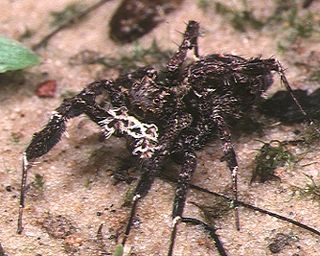
Jumping spiders or the Salticidae are a family of spiders. As of 2019, it contained over 600 described genera and over 6000 described species, making it the largest family of spiders at 13% of all species. Jumping spiders have some of the best vision among arthropods and use it in courtship, hunting, and navigation. Although they normally move unobtrusively and fairly slowly, most species are capable of very agile jumps, notably when hunting, but sometimes in response to sudden threats or crossing long gaps. Both their book lungs and tracheal system are well-developed, and they use both systems. Jumping spiders are generally recognized by their eye pattern. All jumping spiders have four pairs of eyes, with the anterior median pair being particularly large.
Amphidraus is a genus of South American jumping spiders first described by Eugène Simon in 1900. It was previously considered a synonym of Nebridia, but this was later rejected by Jerzy Prószyński, who claimed that merging the two genera wasn't supported by previous diagnostic drawings.

Bagheera is a genus of jumping spiders within the family Salticidae, subfamily Salticinae and subtribe Dendryphantina. The genus was first described by George Peckham & Elizabeth Peckham in 1896. The name is derived from Bagheera, a character from Rudyard Kipling's Jungle Book.
Capeta is a genus of spiders in the family Salticidae.
Helvetia is a Neotropical genus of the spider family Salticidae. The genus name is derived from Helvetia.
Hyetussa is a genus of the spider family Salticidae.
Kalcerrytus is a genus of spiders in the jumping spider family, Salticidae.

Thiodina is a genus of jumping spiders that was first described by Eugène Louis Simon in 1900.

The Spartaeinae are a subfamily of the spider family Salticidae. The subfamily was established by Fred R. Wanless in 1984 to include the groups Boetheae, Cocaleae, Lineae, Codeteae and Cyrbeae, which in turn were defined by Eugène Simon.
Matagaia is a genus of jumping spiders. Its only species, M. chromatopus, was only found on Fernando de Noronha Island, an isolated group of volcanic islands located in the South Equatorial Atlantic, about 350 km from the nearest Brazilian mainland.
Soesilarishius is a spider genus of the jumping spider family, Salticidae.
Soesiladeepakius is a spider genus of the jumping spider family, Salticidae.

Lapsamita is a genus of spiders in the family Salticidae. It was first described in 2013 by Ruiz. As of 2017, it contains only one Brazilian species, Lapsamita maddisoni.
Plesiopiuka is a monotypic genus of Brazilian jumping spiders containing the single species, Plesiopiuka simplex. It was first described by G. R. S. Ruiz in 2010, and is only found in Brazil.
Urupuyu is a genus of spiders in the family Salticidae. It was first described in 2015 by Ruiz & Maddison. As of 2017, it contains 3 species, all from Ecuador.
Edwardsya is a genus of spiders in the family Salticidae. It was first described in 2016 by Ruiz & Bustamante. As of 2017, it contains 2 species, both from Brazil. The genus is placed in subtribe Freyina, part of the Salticoida clade in the subfamily Salticinae.
Tartamura is a genus of South American jumping spiders first described by A. A. Bustamante & Gustavo Rodrigo Sanches Ruiz in 2017. Tartamura was placed in the tribe Thiodinini, part of the Amycoida clade of the subfamily Salticinae in Maddison's 2015 classification of the family Salticidae.
Matinta is a genus of South American jumping spiders. The largest number of species are found in Brazil.

The Sitticini are a tribe of spiders in the family Salticidae. The tribe has been divided into two subtribes, Aillutticina, with five Neotropical genera, and Sitticina, with five genera from Eurasia and the Americas. One genus is unplaced within the tribe. The taxonomy of the tribe has been subject to considerable uncertainty. It was clarified in 2020.





